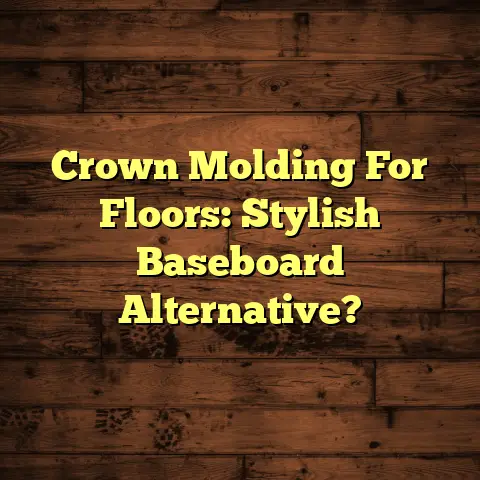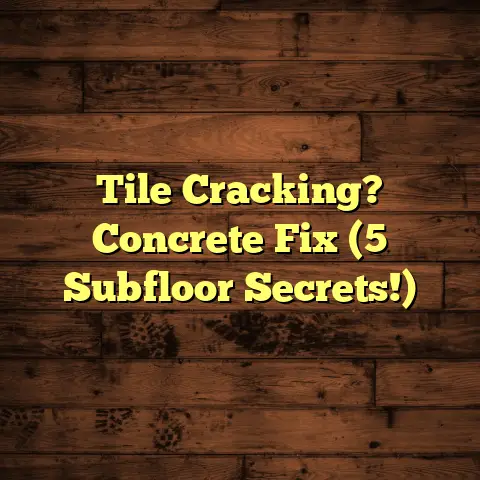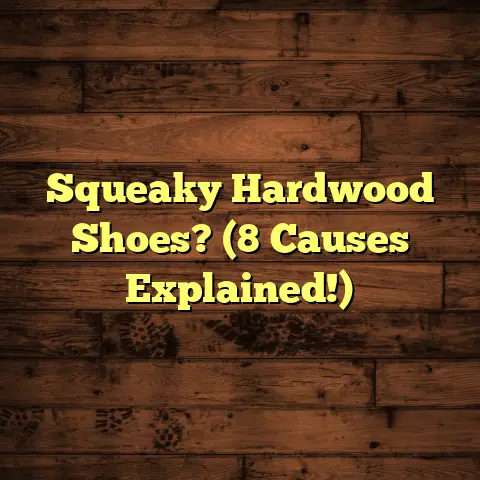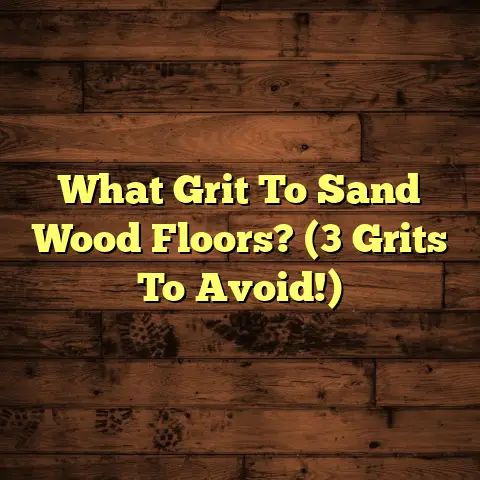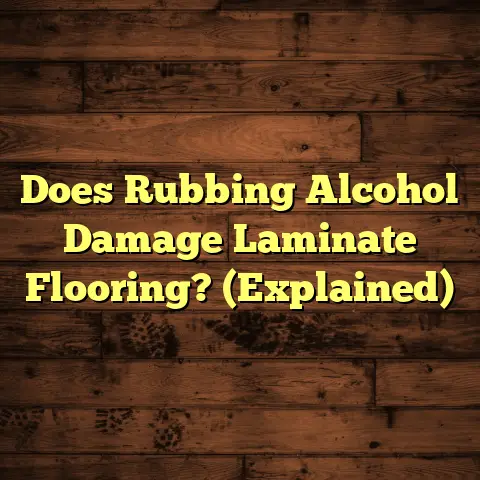Best Hardwood Floors To Buy? (Top 3 Picks!)
Choosing hardwood floors can feel like a big decision, right? It’s a long-term investment and you want to get it right.
Let me tell you, as a flooring contractor with years of experience, I’ve seen it all.
The Analogy: Your Floors are Like Your Favorite Shoes
Think about your favorite pair of shoes.
The ones that fit perfectly, look great, and you know will last for years.
Choosing hardwood floors is similar.
You want something stylish, durable, and comfortable underfoot.
Just like shoes, the right floors can transform how you feel in your home.
They add warmth, character, and value. Plus, they boost your confidence in your home.
I’m here to help you find that “perfect fit” for your home with my top three hardwood picks!
1. Understanding Hardwood Floors
So, what exactly are hardwood floors?
Simply put, they’re floors made from a single piece of wood (solid hardwood) or multiple layers (engineered).
Solid Hardwood: This is the classic choice. It’s one solid piece of wood, typically ¾ inch thick. It can be sanded and refinished multiple times.
Engineered Hardwood: This consists of a thin layer of hardwood veneer on top of a plywood core. It’s more resistant to moisture and temperature changes than solid hardwood, making it suitable for basements.
Benefits of Hardwood Floors:
- Durability: With proper care, hardwood can last for decades.
- Aesthetic Appeal: It adds timeless beauty and elegance to any room.
- Increased Home Value: Hardwood floors are a major selling point for buyers.
- Healthier Indoor Air Quality: Unlike carpets, hardwood doesn’t trap dust or allergens.
Environmental Considerations:
It’s important to consider the source of your hardwood. Look for certifications like the Forest Stewardship Council (FSC). This ensures the wood comes from responsibly managed forests.
2. Factors to Consider When Buying Hardwood Floors
Before diving into my top picks, let’s talk about what to consider when choosing hardwood floors.
Durability: The Janka Hardness Test
The Janka hardness test measures the resistance of a wood species to denting and wear.
The higher the number, the harder the wood.
For example, Brazilian Walnut (Ipe) has a Janka rating of 3680, making it incredibly durable.
In contrast, American Cherry has a Janka rating of 950.
While it’s beautiful, it’s more susceptible to scratches.
I typically recommend a Janka rating of 1000 or higher for high-traffic areas or homes with pets.
Style & Aesthetic: Wood Species
The type of wood dramatically impacts the look and feel of your floors.
-
Oak: A classic choice, oak is durable, readily available, and takes stain well. Red oak has a reddish tint, while white oak is more neutral. It’s my go-to for clients who want a timeless, versatile look.
-
Maple: Maple has a light, creamy color and a fine, uniform grain. It’s a good choice for modern or minimalist spaces. But it can be a bit more challenging to stain evenly.
-
Cherry: Cherry is known for its rich, reddish-brown color and smooth grain. It adds warmth and elegance to any room. However, it’s softer than oak or maple and can darken over time.
-
Hickory: Hickory is one of the hardest domestic hardwoods. It has a bold grain pattern and a rustic look. It’s perfect for creating a warm and inviting atmosphere.
Finish Options: Pre-Finished vs. Unfinished
Pre-finished floors come with the finish already applied at the factory. This saves time and mess during installation. They also often have a more durable finish than site-finished floors.
Unfinished floors are installed raw and then sanded and finished on-site. This allows for complete customization of the stain and finish. But it’s a more time-consuming and labor-intensive process.
Cost: What to Expect
The cost of hardwood floors varies depending on the type of wood, the finish, and the installation method.
Generally, you can expect to pay anywhere from $8 to $25 or more per square foot installed.
-
Material Costs: Exotic hardwoods like Brazilian Walnut or Tigerwood will be more expensive than domestic options like oak or maple.
-
Installation Costs: Nail-down or glue-down installations are typically more expensive than floating installations.
-
Finish Costs: Site-finishing adds to the overall cost due to the extra labor and materials involved.
Installation Methods:
-
Nail-Down: This method is typically used for solid hardwood. The boards are nailed directly to the subfloor.
-
Glue-Down: This method is suitable for both solid and engineered hardwood. The boards are glued to the subfloor using a special adhesive.
-
Floating: This method is commonly used for engineered hardwood. The boards are connected to each other and “float” over the subfloor. It’s a faster and easier installation method than nail-down or glue-down.
3. Top 3 Picks for Hardwood Floors
Okay, let’s get to the good stuff! Based on my experience, here are my top three picks for hardwood floors:
Pick 1: Bruce Dundee Plank
Description:
The Bruce Dundee Plank is a solid oak hardwood floor known for its classic beauty and exceptional durability.
It features a traditional smooth surface with a micro-beveled edge, giving it a seamless appearance.
It’s available in a variety of colors, from light and airy to rich and dark.
Pros:
- Durability: Made from solid oak, it can withstand heavy foot traffic.
- Timeless Style: The classic oak grain complements any décor.
- Refinishable: It can be sanded and refinished multiple times, extending its lifespan.
- Warranty: Bruce offers a solid warranty on their products, giving you peace of mind.
Cons:
- Moisture Sensitivity: Solid hardwood is susceptible to moisture damage. It’s not recommended for basements or bathrooms.
- Price: It can be more expensive than some engineered options.
Price Range:
Expect to pay around $6 to $9 per square foot for the material. Installation costs will vary depending on your location and the complexity of the project, but typically range from $3 to $5 per square foot.
You can find Bruce Dundee Plank at most major flooring retailers, including Home Depot and Lowe’s.
Pick 2: Shaw Repel Water Resistant Hardwood
Description:
The Shaw Repel is an engineered hardwood floor designed to resist water damage.
It features a waterproof core and a durable wear layer, making it ideal for kitchens, bathrooms, and other moisture-prone areas.
It’s available in a variety of wood species, including oak, maple, and hickory.
Pros:
- Water Resistance: It can withstand spills and splashes without warping or buckling.
- Durability: The durable wear layer resists scratches and dents.
- Easy Maintenance: It’s easy to clean and maintain.
- Versatile Style: It’s available in a wide range of colors and styles to suit any taste.
Cons:
- Not Waterproof: While it’s water-resistant, it’s not completely waterproof. Standing water should be cleaned up promptly.
- Price: It can be more expensive than traditional engineered hardwood.
Price Range:
Expect to pay around $7 to $12 per square foot for the material. Installation costs will vary, but typically range from $3 to $5 per square foot.
You can find Shaw Repel at flooring retailers like Flooring America and independent flooring stores.
Pick 3: Cali Bamboo Fossilized Bamboo Flooring
Description:
Cali Bamboo Fossilized Bamboo Flooring is an eco-friendly option made from sustainably harvested bamboo.
It’s incredibly durable and resistant to scratches and dents.
It’s available in a variety of colors and styles, including traditional planks and wide planks.
Pros:
- Eco-Friendly: Bamboo is a rapidly renewable resource.
- Durability: It’s harder than many traditional hardwoods.
- Unique Style: It has a distinctive look that adds character to any room.
- Warranty: Cali Bamboo offers a comprehensive warranty on their products.
Cons:
- Price: It can be more expensive than some traditional hardwoods.
- Limited Availability: It may not be available at all flooring retailers.
- Moisture Sensitivity: While it’s more water-resistant than solid hardwood, it’s still susceptible to moisture damage.
Price Range:
Expect to pay around $8 to $15 per square foot for the material. Installation costs will vary, but typically range from $3 to $5 per square foot.
You can find Cali Bamboo at specialty flooring stores and online retailers like Wayfair and Lumber Liquidators.
4. Comparative Analysis
Okay, let’s break down how these three picks stack up against each other:
| Feature | Bruce Dundee Plank (Solid Oak) | Shaw Repel (Engineered) | Cali Bamboo (Fossilized Bamboo) |
|---|---|---|---|
| Durability | High | High | Very High |
| Water Resistance | Low | Medium | Medium |
| Style | Classic | Versatile | Unique |
| Price | Medium | Medium-High | Medium-High |
| Eco-Friendliness | Low | Low | High |
| Best For | Living Rooms, Bedrooms | Kitchens, Bathrooms | Any Room |
-
Bruce Dundee Plank: Best for homeowners who want a classic, timeless look and are willing to take extra care to protect their floors from moisture.
-
Shaw Repel: Best for homeowners who want the look of hardwood in moisture-prone areas like kitchens and bathrooms.
-
Cali Bamboo: Best for homeowners who want an eco-friendly, durable flooring option with a unique style.
5. Conclusion
Choosing the right hardwood floor is a big decision, but it doesn’t have to be overwhelming.
By considering factors like durability, style, and cost, you can find the perfect flooring to suit your needs and budget.
My top three picks – Bruce Dundee Plank, Shaw Repel, and Cali Bamboo – offer a range of options for different lifestyles and preferences.
Remember, just like your favorite pair of shoes, the right hardwood floors can transform your home into a comfortable, stylish, and inviting space for years to come.
So, take your time, do your research, and choose wisely. Your feet (and your home) will thank you for it!

